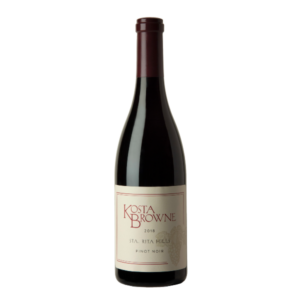Winemaker Notes
Each year, our goal for Sea Smoke Southing Sta. Rita Hills Pinot Noir is to create the ideal marriage of complexity and elegance. The ever-changing nose of the Southing exhibits Montmorency cherry, sage, hibiscus and subtle baking spices. The fine tannins and minerality are enhanced by our estate vineyard’s characteristic cool climate acidity.
Southing refers to the south-facing hillside bluffs found on our estate vineyard. Each year, our goal for this wine is to create the ideal marriage of complexity and elegance. Southing is a true expression of the terroir of Sea Smoke Vineyard: seductive flavors and fine tannins complimented by cool climate acidity.
Winemaking: Hand-harvested, clusters were sorted in the vineyard and then gently destemmed following an evening in our cold room. All ‘jack stems’ were removed on the sorting table. Musts were cold soaked in open-top fermenters for five days, and then inoculated with cultured yeasts to begin slow fermentation. Each tank was manually punched down two times per day, with a total maceration time of fourteen to eighteen days. Upon completion of primary fermentation and maceration, all free run wine was transferred to tank for settling and then pressed at extremely low pressure (0.08 bars) to avoid extracting bitterness. After settling overnight both free-run and press wines were racked to barrels. Southing was bottled with no fining and no filtration.
Character: Each year, our goal for Southing is to create the ideal marriage of complexity and elegance. The ever-changing nose of the Southing exhibits Watermelon, Jasmine, Victoria plum; and subtle baking spices. The fine tannins and minerality are enhanced by our estate vineyard’s characteristic cool climate acidity.
About Sea Smoke Estate Vineyards
Our estate vineyard is located in the northern hemisphere’s southernmost – and sunniest – Region 1 microclimate, which has the coolest temperatures for grape growing. The Pacific Ocean fog (‘sea smoke’) funnels across our hillsides each afternoon, creating ideal growing conditions for Pinot Noir.
Our Pinot Noir vines are planted on south-facing hillside bluffs, in ‘transition zones’ characterized by rich clay soils, aiding us in our quest for quality. This is where Pinot Noir finds its most sublime expression.
We farm our estate vineyard both organically and biodynamically, because nurturing the soil and vines – without toxic chemicals and in harmony with nature – is the right thing to do for the land, for our employees and for our customers.
Sea Smoke’s unique combination of sun, fog, soil and meticulous farming results in wines that are lush, elegant and expressive.
While our small team would love to take credit, if there’s a star in the Sea Smoke story, it’s not a person, but the rare and magical property that for years local vintners coveted for its potential to grow great Pinot Noir. In 1999, this land in the heart of Santa Barbara’s Santa Rita Hills AVA became Sea Smoke Vineyard. Located on south-facing hillside bluffs, our Sea Smoke Estate receives plenty of sunshine – but then, so does most of California. What makes our vineyard truly special is its shallow clay soils, south facing slopes, and the layer of marine fog (sea “smoke”) that travels up the Santa Ynez River canyon each evening, cooling our vines. This cooling influence makes extended ‘hangtime’ possible prior to harvest – allowing flavors and tannins to fully mature, while still maintaining lovely acidity. This results in wines that are lush, elegant and expressive.
Because we are an estate winery and the California equivalent of a ‘Monopole’, we do not buy or sell grapes. Our obsession with Pinot Noir has its roots – literally and figuratively – in our estate vineyard, and our obsession is apparent in the way we farm. We strive for low crop yields and small grape clusters, so our vineyard is planted with ten top-quality Pinot Noir clones on vigor-reducing rootstocks. Every one of our vines receives individual care and handling from our vineyard crew at least eight times a year – every single vine. Since our estate vineyard will hopefully outlast us all, we decided to be good stewards of the land: we have been farming sustainably for over a decade, and in 2013 we went beyond organic and began farming our entire vineyard biodynamically.
Because lab tests never tell the whole story, we ultimately rely on our taste buds to decide when to begin harvesting individual blocks. The east and west sides of each block are usually picked at different times, for example, and after hand harvesting, grapes are chilled overnight, pre-sorted, de-stemmed and then carefully table sorted. Meanwhile, we evaluate the clonal characteristics and tannin profile of each and every harvested block, tailoring our corresponding fermentations accordingly. We keep each block and clone combination separate throughout fermentation and aging. This helps us develop a deep understanding of the characteristics of each vineyard block, observing how each responds to specific barrel profiles in our cellar, and ultimately gives us an array of flavors and characteristics to draw upon during blending.





